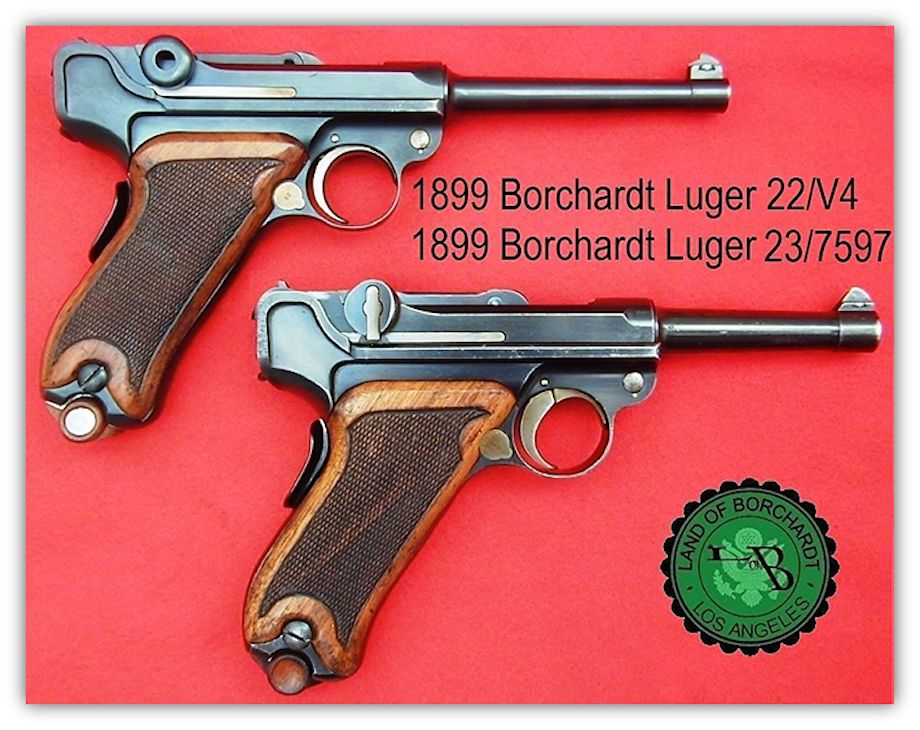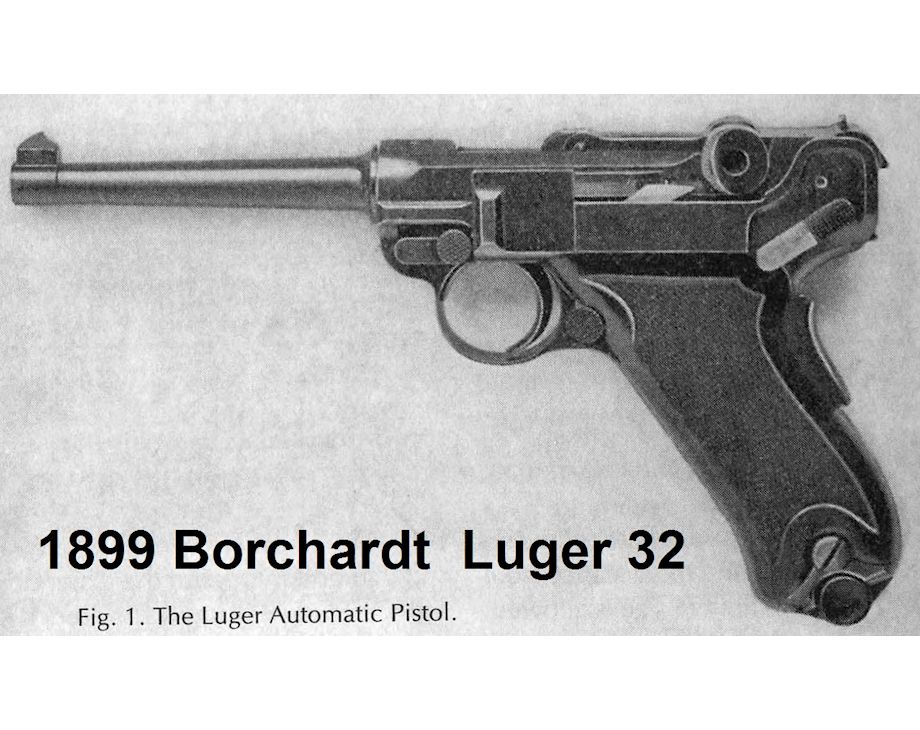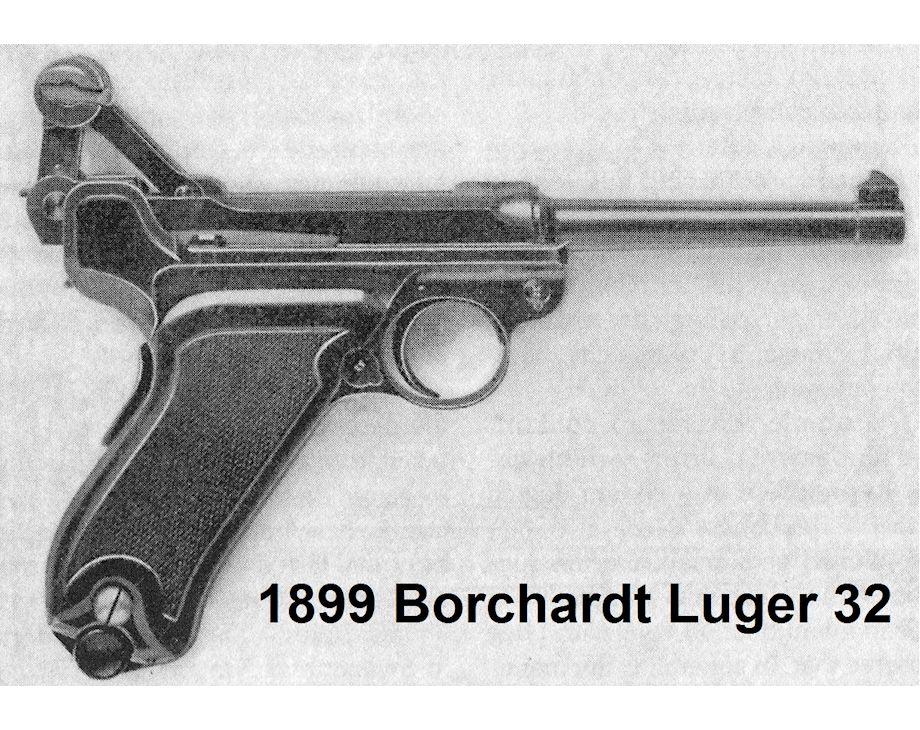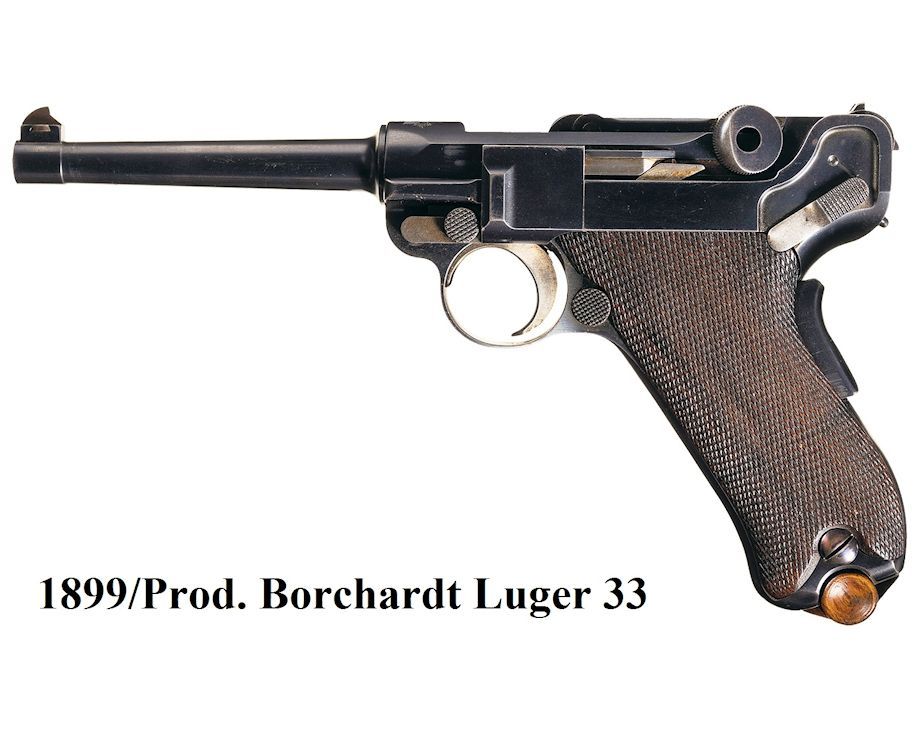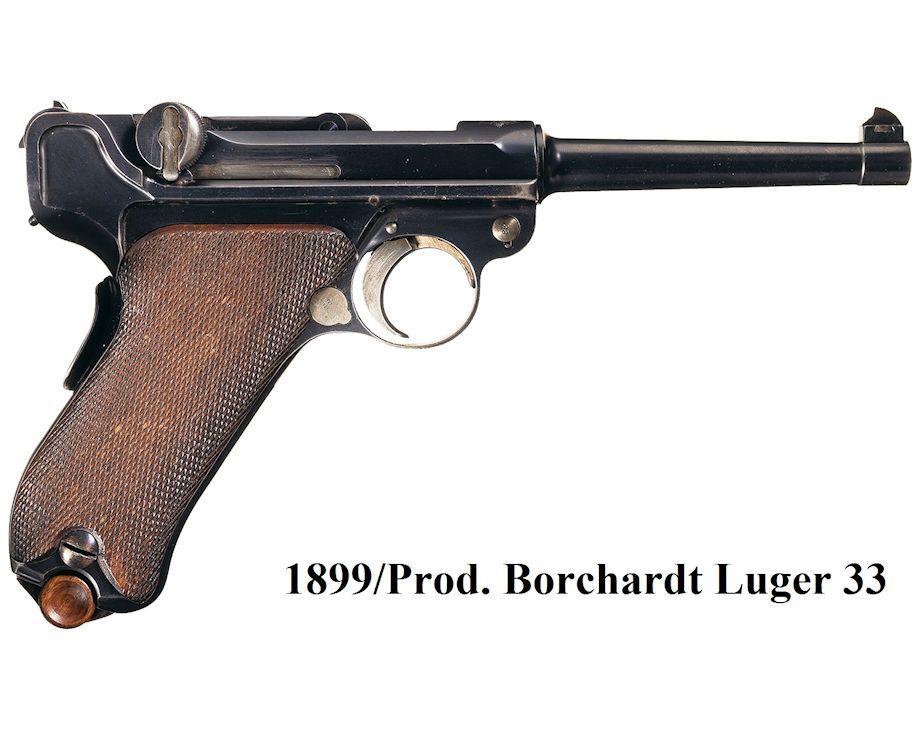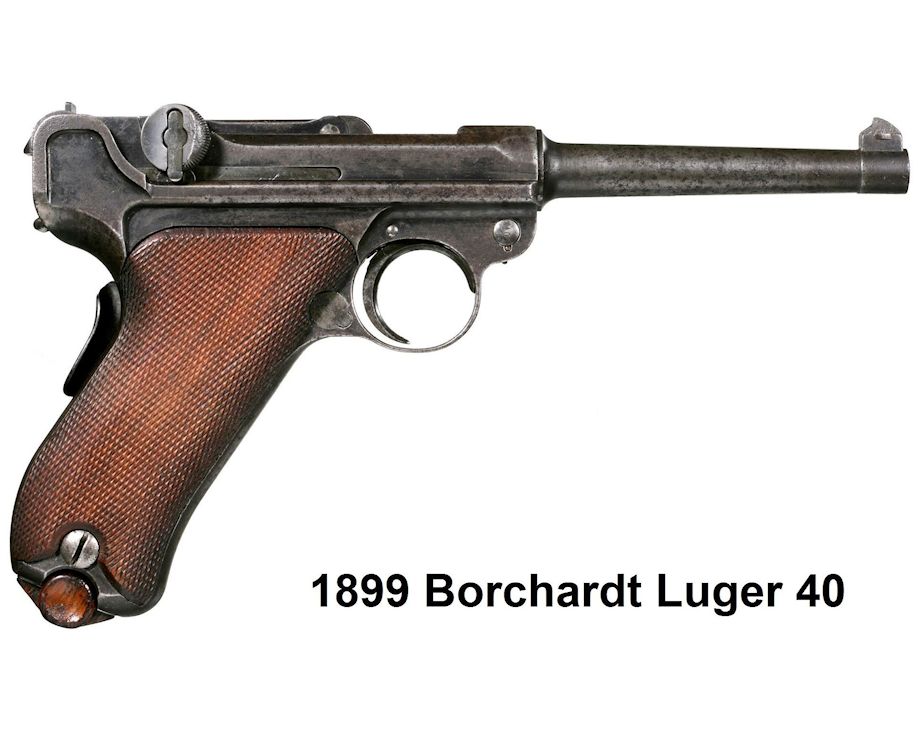
Mouse over image to right side of 1899 Borchardt Luger 22 and 23.
Replacement 4″ 9mm Krieghoff barrel with SN 7597 on bottom. 1937 above chamber on Krieghoff receiver numbered 7597 on left side 1937 above chamber on Krieghoff receiver numbered 7597 on left side with Eagle/2 proofs on right. Original M1899/00 Toggle assembly numbered 23 with original long (51 mm) bolt (breechblock) with original M1899 prototype double firing pin springs/retainer/firing pin assembly. with Eagle/2 proofs on right. Original M1899/00 Toggle assembly numbered 23 with original long (51 mm) bolt (breechblock) with original M1899 prototype double firing pin springs/retainer/firing pin assembly. Prototype blank center toggle link, dished toggles with Luger’s modified (in 1900) rounded hinge tongue, toggle latch and prototype style numbering and placement. Prototype blank center toggle link, dished toggles with Luger’s modified (in 1900) rounded hinge tongue, toggle latch and prototype style numbering and placement. Krieghoff side plate is SN 97. Early DWM takedown lever is SN 69. Frame and all parts thereto is original prototype numbered 23 on back above lanyard loop. Krieghoff side plate is SN 97. Early DWM takedown lever is SN 69. Frame and all parts thereto is original prototype numbered 23 on back above lanyard loop. Trigger, magazine release button, grip safety and prototype wide border checkered pale walnut grips are all SN 23. Trigger, magazine release button, grip safety and prototype wide border checkered pale walnut grips are all SN 23. Prototype flat safety lever has no visible numbers. Prototype frame remains unrelieved. Early flat button wood bottom magazine. Prototype flat safety lever has no visible numbers. Prototype frame remains unrelieved. Early flat button wood bottom magazine. This is an 1899 Luger prototype, originally delivered to Switzerland for their 1899 troop trials, and then taken back to the DWM factory after Swiss adoption in May 1900 and updated with Luger’s post-trial improvements. It was then delivered to the British Small Arms Committee in October 1900, with five other similarly updated M1899/00 pistols, for British Army trials and is the pistol mentioned by serial number in the report of the Commandant of the School of Musketry at Hythe in his report of ballistics and wounding trials conducted there in March 1901. This is an 1899 Luger prototype, originally delivered to Switzerland for their 1899 troop trials, and then taken back to the DWM factory after Swiss adoption in May 1900 and updated with Luger’s post-trial improvements. It was then delivered to the British Small Arms Committee in October 1900, with five other similarly updated M1899/00 pistols, for British Army trials and is the pistol mentioned by serial number in the report of the Commandant of the School of Musketry at Hythe in his report of ballistics and wounding trials conducted there in March 1901. It was returned to the Pattern Room at the Royal Small Arms Factory at Enfield Lock and later reworked by SOE (British SOE (Special Operations Executive) during WWII for assassination work in German occupied Europe.) in WWII with a Krieghoff bbl., receiver and side plate to make it serviceable with 9 mm ammunition for clandestine service in the war. Most important, apart from the replacement barrel/receiver assembly, side plate and stripping latch all components are original M1899/00 prototype parts. A great study in development of first Luger pistols and a remarkable proof of the correctness of Luger’s original design in that it is interoperable with much later Krieghoff parts in a caliber not even conceived of when the pistol was first made. This gun is featured on p. 182 of The Borchardt & Luger Automatic Pistols by †Joachim Görtz & Dr. Geoffrey Sturgess. It was returned to the Pattern Room at the Royal Small Arms Factory at Enfield Lock and later reworked by SOE (British SOE (Special Operations Executive) during WWII for assassination work in German occupied Europe.) in WWII with a Krieghoff bbl., receiver and side plate to make it serviceable with 9 mm ammunition for clandestine service in the war. Most important, apart from the replacement barrel/receiver assembly, side plate and stripping latch all components are original M1899/00 prototype parts. A great study in development of first Luger pistols and a remarkable proof of the correctness of Luger’s original design in that it is interoperable with much later Krieghoff parts in a caliber not even conceived of when the pistol was first made. This gun is featured on p. 182 of The Borchardt & Luger Automatic Pistols by †Joachim Görtz & Dr. Geoffrey Sturgess. PROVENANCE: Pattern Room, Enfield (complete with UK MoD QAD Release Order dated 19/11/86), PROVENANCE: Pattern Room, Enfield (complete with UK MoD QAD Release Order dated 19/11/86), Collection of Dr. Geoffrey Sturgess. CONDITION: Excellent. Retaining 95% original bright DWM blue on toggle assembly and frame with light wear and scratches. Rear grip strap has pitting towards bottom. Strawed parts retain 90% original blue. Barrel, receiver and side plate retain 95% original bright Krieghoff blue with wear on sharp edges and corners. Bore is worn with frosting. Grips are excellent with light dings and dents. Magazine has a few areas of light corrosion on body and very little wear on wood bottom. Mechanics are excellent. 4-52737 BWS144 (25,000-50,000) – Collection of Dr. Geoffrey Sturgess. CONDITION: Excellent. Retaining 95% original bright DWM blue on toggle assembly and frame with light wear and scratches. Rear grip strap has pitting towards bottom. Strawed parts retain 90% original blue. Barrel, receiver and side plate retain 95% original bright Krieghoff blue with wear on sharp edges and corners. Bore is worn with frosting. Grips are excellent with light dings and dents. Magazine has a few areas of light corrosion on body and very little wear on wood bottom. Mechanics are excellent. 4-52737 BWS144 (25,000-50,000) –
PROVENANCE
The above October 2014 J.D. Julia auction description of 1899/00 Borchardt Luger 23/7597, a.k.a. BL23/7597, is reasonably accurate in the physical description of BL23/7597. However, the description fails to note that one leaf of the original dual leaf flat Riband recoil spring was broken, which is clearly visible in one of their catalog pictures. The auction house used information provided by G. L. Sturgess, plus a generous dose of in-house auction hype, portraying an unusual romp or trail through history. The story starts at DWM in November 1899 when Borchardt Luger 23, along with 19 other Borchardt Lugers were submitted to the Swiss Ordnance for test trials. As a result of the Swiss trials, several (ten) pistols were returned to DWM to incorporate changes as a consequence of those tests. Of those returned, six modified pistols were submitted to the British for trials. One of these pistols was 1899/00 Borchardt Luger 23, which was used in tests at the School of Musketry at Hythe, March 1901. The auction house used information provided by G. L. Sturgess, plus a generous dose of in-house auction hype, portraying an unusual romp or trail through history. The story starts at DWM in November 1899 when Borchardt Luger 23, along with 19 other Borchardt Lugers were submitted to the Swiss Ordnance for test trials. As a result of the Swiss trials, several (ten) pistols were returned to DWM to incorporate changes as a consequence of those tests. Of those returned, six modified pistols were submitted to the British for trials. One of these pistols was 1899/00 Borchardt Luger 23, which was used in tests at the School of Musketry at Hythe, March 1901.
The first mention of 1899/00 Borchardt Luger 23 is in a © 1996 British publication titled: The Journal of the Historical Breechloading Smallarms Association or HBSA, Vol 2 No 9 in an article titled: From Borchardt to Parabellum, An Anglo-Swiss Connection by Dr. G L Sturgess. in an article titled: From Borchardt to Parabellum, An Anglo-Swiss Connection by Dr. G L Sturgess.
It is not certain, that privately, Sturgess completely believes that BL23 was modified by the SOE in WW2 for clandestine activities as evidenced by his in-house inventory tag description when, as part of his collection since 1986, simply states, with no mention of SOE involvement: Barrel/receiver exchanged for Krieghoff assembly at MoD QAD (W) during WWII era. Additionally, the 1996 HBSA article and both later book publications © 2010 Pistole Parabellum Additionally, the 1996 HBSA article and both later book publications © 2010 Pistole Parabellum and © 2010 – 2011 The Borchardt & Luger Automatic Pistols and © 2010 – 2011 The Borchardt & Luger Automatic Pistols BL23 book descriptions are conspicuously silent regarding the modified configuration, with no mention or implication of SOE involvement, although for auction promotional hype the SOE connection was most likely added by J.D. Julia, although the entire description does exhibit the grammatical Sturgess footprint, to enhance the importance/desirability of BL23 for obvious monetary reasons, which were not needed, as its rarity and importance to collectors and history are self-evident. BL23 book descriptions are conspicuously silent regarding the modified configuration, with no mention or implication of SOE involvement, although for auction promotional hype the SOE connection was most likely added by J.D. Julia, although the entire description does exhibit the grammatical Sturgess footprint, to enhance the importance/desirability of BL23 for obvious monetary reasons, which were not needed, as its rarity and importance to collectors and history are self-evident.
Interestingly, BL23 is described, as mentioned above, in The Borchardt & Luger Automatic Pistols, a.k.a. TBLAP © 2010 & 2011 by Görtz/Sturgess in Volume I, Chapter 3, Development of the Parabellum Pistole, page 206, UK Trial sns: with no mention of its configuration or any connection with the SOE, nor as to why it is identified simply as BL23, not BL23/7597 is given short shrift in the book, simply stating on page 206 that: Pistol sn. 23 is in a private collection, having been in the Pattern Room collection (also referring to BL26) until the mid-1980s. A curious omission of the modified configuration status of BL23 in TBLAP where, in the October 2014 J.D. Julia auction description, there is much historical emphasis or importance placed on the modified configuration, is attributed to BL23, pictured in the auction catalog and web site, unabashedly referred to as BL23/7597. A curious omission of the modified configuration status of BL23 in TBLAP where, in the October 2014 J.D. Julia auction description, there is much historical emphasis or importance placed on the modified configuration, is attributed to BL23, pictured in the auction catalog and web site, unabashedly referred to as BL23/7597.
Possibly more tests were conducted with serial number 23. However, in the early part of the 20th century, serial number 23 was purportedly returned to the Pattern Room to reside for about 36 years, to around 1940 or later. It was, again purportedly, retrieved and modified by the SOE (British SOE (Special Operations Executive) during WWII for assassination work in German occupied Europe.[1]) Modified serial number 23, sometime after WWII, again purportedly, now as 23/7597 was returned to the Pattern Room where it resided for about 40 years. In 1986, it was acquired by Sturgess who, after 28 years in his collection, offered it at auction in October 2014. offered it at auction in October 2014.
The 1900/01 British trials of the six 1899/00 Borchardt Lugers were first discussed and described in a © 1977 publication titled: LUGER by John Walter . Although the information presented was not completely accurate, it was correct in identifying six 1899/00 modified Borchardt Lugers were submitted. Specifically identified were Borchardt Luger serial numbers 23, 25 and 26, these were known to “be in the batch”. 1899/00 Borchardt Luger 26 first appeared in a © 1971 publication titled: German Pistols and Revolvers 1871 – 1945 by †Ian V. Hogg. . Although the information presented was not completely accurate, it was correct in identifying six 1899/00 modified Borchardt Lugers were submitted. Specifically identified were Borchardt Luger serial numbers 23, 25 and 26, these were known to “be in the batch”. 1899/00 Borchardt Luger 26 first appeared in a © 1971 publication titled: German Pistols and Revolvers 1871 – 1945 by †Ian V. Hogg. The identical picture of 1899/00 Borchardt Luger 26 was pictured in the © 1977 Walters publication with the caption statement: Pattern Room Collection, credit: †Ian Hogg. The identical picture of 1899/00 Borchardt Luger 26 was pictured in the © 1977 Walters publication with the caption statement: Pattern Room Collection, credit: †Ian Hogg. The same picture was again used in Walters © 1986 follow-up publication titled: The Luger Book. The same picture was again used in Walters © 1986 follow-up publication titled: The Luger Book.
The above information is interesting in as much as 1899/00 Borchardt Luger 23/7597 is recorded to have been in the Pattern Room in 1986. Yet only 1899/00 Borchardt Luger 26 has been documented to have been in the Pattern Room since 1971 and if serial number 23 was in the Pattern Room in the same time frame it was well hidden. There are no known published, official MoD Pattern Room release documents for 1899 Borchardt Lugers 14, 25 or 30.
The time frame that BL23/7597 was in the possession of SOE is unknown and unsubstantiated. Without any supportive documentation, this is only speculative conjecture by Sturgess, and considering the classified nature of the subject, may never be known. However, the following facts concerning BL23 are unrefuted:
- Was tested by the Swiss in the early 1900’s as a 30 Cal, 120mm barrel, DWM 1899 Swiss Trials Borchardt Luger.
- Submitted to the British for testing in October 1900 as a DWM Berlin tool room modified 1899/00 120mm barrel Borchardt-Luger.
- Resided after testing, more or less, for 80 years in the Pattern Room.
- Acquired by Sturgess in 1986 from the Pattern Room with a 1937 chamber dated Krieghoff 9mm barrel/receiver replacement.
The replacement of a 1937 Krieghoff Luger barrel/receiver assembly in BL23 is not so far-fetched an idea. During the war, a German Army Mauser Luger would not be readily available. For example, many Luftwaffe planes were shot down and crashed during the 1940 Battle of Britain. Undoubtedly, some Krieghoff Lugers with salvageable parts were recovered and this would be the only way of Britain obtaining a Krieghoff Luger, or parts thereof, early on in the war.
Additionally, it would be a significant event if BL23 was removed and returned to the Pattern Room lending historical importance to BL23, now BL23/7597. However, there is no supporting documentation to support this claim. Additionally, reworked as BL23/7597 purportedly by the SOE, it probably never left Britain, as if it did find its way “behind enemy lines”, it would have been a one way trip. The odds of it having been returned to the Pattern Room is slim to none. An alternate theory is that BL23 was in a private collection and subsequently modified to 9mm. It never left Britain but was ultimately recognized for what it was and somehow found its way “back” into the MoD Pattern Room.
Documented British test history of 1899/00 Borchardt Luger 23. TBLAP V1 C3
The Commandant of the School of Musketry at Hythe, Col. James, conducted experiments on live and dead animals during the 1901 time frame. A page of notes written on 7 March 1901 by the officer responsible for these "mutton" trials and also for performing velocity trials, very probably Col. James himself, shows that pistol sn. 23 was one of the two dispatched to Hythe. In TBLAP V1 C3 on page 187, Sturgess states The trial report covered detailed comparative medical appraisal of the wounds caused by the "Borchardt", as the Parabellum was still referred to by the SAC... In TBLAP V1 C3 on page 187, Sturgess states The trial report covered detailed comparative medical appraisal of the wounds caused by the "Borchardt", as the Parabellum was still referred to by the SAC... . Fig. 3-99 from TBLAP V1 C3 on page 188 shows Two pages of notes, 54 and 55, made at the wounding and ballistic trials of the Parabellum at the School of Musketry in Hythe during March 1901, showing M1899/00 pistol sn. 23 to have been used for this work. . Fig. 3-99 from TBLAP V1 C3 on page 188 shows Two pages of notes, 54 and 55, made at the wounding and ballistic trials of the Parabellum at the School of Musketry in Hythe during March 1901, showing M1899/00 pistol sn. 23 to have been used for this work. . .
It appears that BL23 was also used for velocity tests (ballistic trials per Sturgess) based on the page 55 notes, where it identifies only BL23 by serial number. The page 55 note states: Object of tests-To obtain velocity for the Borchardt-Luger Pistols, where it identifies only BL23 by serial number. The page 55 note states: Object of tests-To obtain velocity for the Borchardt-Luger Pistols, The notes cite both wounding (stopping-power trials per Walter) and velocity tests, J. Walter states in detail in his book LUGER © 1977, page 59: Disregarding the results of the stopping-power, the commandant of the School of Musketry reported that the Borchardt-Luger had undergone a very successful shooting trial on the target range. The notes cite both wounding (stopping-power trials per Walter) and velocity tests, J. Walter states in detail in his book LUGER © 1977, page 59: Disregarding the results of the stopping-power, the commandant of the School of Musketry reported that the Borchardt-Luger had undergone a very successful shooting trial on the target range.
From detailed comparative examination of the two pistols, sn 23 and sn 26 (see Fig 3-101) and sn 26 (see Fig 3-101) , their British trials provenance is indisputable as both have been in the former RSAF Enfield Pattern Room collection since the turn of the 20th century… , their British trials provenance is indisputable as both have been in the former RSAF Enfield Pattern Room collection since the turn of the 20th century… from TBLAP V1 C3, page 190. from TBLAP V1 C3, page 190.

Fig. 3-103: Comparison of the trigger spring seating groove at the rear of the trigger guard of an unaltered M1899, British trials M1899/00 and production P.00 pistol clearly shows the widening of the groove in the M1899/00 to accommodate the production pattern trigger/spring fitted to these British trials guns. The edge of the original 5 mm wide groove for the M1899 thin trigger/spring fitted to sn. 23 for the Swiss trial can be clearly seen (arrowed) from TBLAP V1 C3, page 189.
Sturgess discusses in TBLAP the 1899 Borchardt-Lugers tested in Britain in THE BORCHARDT-LUGER PISTOLS CHAPTER 3 – DEVELOPMENT OF THE PARABELLUM PISTOL in a section titled: The 1900 British Trials pistols: The Anglo-Swiss connection and is presented herein for reference with sections dealing with BL23.
The 1900 British Trials pistols: the Anglo-Swiss connection
As noted above, Luger was unable to comply with the British request for six pistols for trial, formalized to Vickers in May 1900, until mid-October that year, which indicated that there was no stock, or certainly not six pistols, available at the factory during that summer when the Swiss adoption was being negotiated into a commercial contract. It has been reported that the Swiss returned all 20 troop trials 1899 prototype pistols to the DWM factory at the conclusion of their trial and adoption after May 1900, and that 10 of these pistols, with the final improvements requested by the Swiss, were returned for presentation to the members of the Swiss Commission. It is clear from the correspondence between the W+F and the KTA, however, that only 10 pistols were returned to Berlin after the trials, and these were eventually replaced in June 1901 with production pistols numbered E601 – E610, so keeping the Swiss books of account in order. Confusingly, these ten pistols were held in reserve as the beginning of the “Extra-Serie” held by the W+F for technical and shooting competition presentation purposes, and were not the pistols presented to the members of the Commission. These ten Commission presentation pistols are recorded in this correspondence (B.A., Bern, B 27/3071-73) to have been standard Swiss military pistols from the regular contract serial range numbered 601 – 610 (without the E suffix – see below). It is apparent, from detailed comparative examination of:
a) two pistols with indisputable British trials provenance, sns 23 & 26 (see Fig 3-101), both having been in the former RSAF Enfield Pattern Room collection since the turn of the 20th century, and of: both having been in the former RSAF Enfield Pattern Room collection since the turn of the 20th century, and of:
b) two other identical pistols with equally long British provenance, sns 25 & 30 (sn 30 with its original trials holster and cleaning rod, identical to those supplied with cased Borchardt pistols (see Fig 3-102), all four of which are identical in their markings and mechanically, in comparison with: all four of which are identical in their markings and mechanically, in comparison with:
c) a wholly original and unmodified 1899 prototype, sn 40 (see Fig 3-98), and also with and also with
d) original unmodified Swiss trials pistols sns 19 & 21 and:
e) the original components of the M1899 pistols remaining in the W+F collection, but modified to M1899/29 configuration with new V prefix serial numbers, that Luger produced these British trials pistols by modification of the Swiss Trials pistols.
The British pistols were originally part of the Swiss troop trials batch of 20, and were modified by Luger to incorporate the "Swiss" improvements, such as the improved trigger (drawn up by Luger on 9 June 1900) and reinforced rear sight, before shipping them to Britain for trial in October 1900.
The most conclusive evidence of this is the modification of the trigger spring retaining groove in the inside rear of the trigger guard on the frame. Detailed comparison between pistols sns 19, 21 & 40, of original, unaltered 1899 pattern, British trials pistols sns. 23, 26 & 30 and the first production 1900 pattern Parabellum, Swiss military contract pistol sn. 01, shows pistols sns. 21 & 40 to have a narrow (5.0 mm width) trigger spring locating groove, centered across the frame, whereas pistols sn 23, 26 & 30 show visible traces of the original 5 mm groove machining overlaid by a widening cut which makes the groove (uniquely among Parabellum pistols) 7.1 mm wide, and aligns its right side with the right side of the trigger pivot block cut-out. Pistol sn 01, the first production Parabellum, has the standardized 6.0 mm wide groove, also aligned to the right side of the pivot block cut out. The triggers of these 1899/00 modified prototype British pistols are a prototype of the production trigger, serial numbered to the pistol, with the minor, but distinctive, machining differences described above. Detailed comparison between pistols sns 19, 21 & 40, of original, unaltered 1899 pattern, British trials pistols sns. 23, 26 & 30 and the first production 1900 pattern Parabellum, Swiss military contract pistol sn. 01, shows pistols sns. 21 & 40 to have a narrow (5.0 mm width) trigger spring locating groove, centered across the frame, whereas pistols sn 23, 26 & 30 show visible traces of the original 5 mm groove machining overlaid by a widening cut which makes the groove (uniquely among Parabellum pistols) 7.1 mm wide, and aligns its right side with the right side of the trigger pivot block cut-out. Pistol sn 01, the first production Parabellum, has the standardized 6.0 mm wide groove, also aligned to the right side of the pivot block cut out. The triggers of these 1899/00 modified prototype British pistols are a prototype of the production trigger, serial numbered to the pistol, with the minor, but distinctive, machining differences described above.

The other major modification that Luger made (shown above) before shipping these pistols to Britain was to change the toggle assembly, but not the breech block, which is the original 1899 prototype component, approximately 1 mm longer than the 1900 production pattern block, and retaining the dual firing pin springs. The modified toggle has the production semi-circular hinge link profile, replacing the original 1899 prototype pattern square profile link, and has the reinforced production pattern rear sight leaf, as requested by the Swiss. The serial numbering of the original item is retained exactly however - small digits to the left side of the front link, large digits read along the axis before the rear sight on the rear link - but the original Swiss toggle’s GL monogram was omitted from the rear link. The rear link side profile is the Old Model production pattern, without the taper to the underside immediately to the rear of the toggle grips. The replacement toggle grips however retain the longer 10º angled lightening relief cut-away behind the fluting of the forward edge of the finger grips, as the original 1899 prototype component (see Figs. 3-87, 89 & 90).
The lateral abutments behind the grips are modified to the production, long style on the five surviving British trial pistols which have been positively identified, sns. 18, 23, 25, 26 and 30 (See Fig. 3-104). Only the left grip of sn 14 is known to survive, but it is unquestionably a genuine 1899 bordered pattern grip, and has long British provenance, as do the other five trials pistols, and can virtually certainly be identified as the sixth British trial pistol serial number. It has been erroneously reported that pistol sn. 25 has short abutments, but this can only be due to ignorance of the actual difference between the original M1899 short abutments and the long abutments of all the British trials pistols. The receivers of the British pistols are the original Swiss trials components, retaining their distinctive pattern Swiss Cross over the chamber, but the abutment mating steps on the tops of the arms are appropriately cut back by 1.3 mm towards the rear axis pin to accommodate the long toggle abutments.
The function of these abutments was the specific subject of one of Luger's batch of German patents of 6 May 1900 covering the Parabellum, DRP 134003, which protects this subtle enhancement of the basic "knee" action of two levers between three pivot points. Such abutments are absent in the Borchardt pistol, but were introduced by Luger from the first patent drawings, DRP 109481/30 Sept 1898 - which shows long abutments, and the 1898 Transitional pattern pistols delivered to Switzerland in November 1898 - which had short abutments. They are designed to take up all initial recoil forces and, by virtue of their geometry in relation to the centre pivot pin axis, when the rear toggle link abutments are initially forced down and back against the mating planes of the receiver, they tend to both force the centre pivot downwards, enhancing the locking action, and to transmit all the recoil forces to the receiver forks. This permits the rear (removable) pivot pin to be a relatively loose fit (for ease of stripping), since it takes no part in the action locking initially when chamber pressures are at their peak, all the recoil forces at this part of the cycle being taken by the abutments and the close fitting between the bolt, front link and rear link around the front and centre pivot pins. The rear pin only serves as a pivot after the "knee" has broken, chamber pressure has dropped and recoil forces are diminishing.
The other major and minor components of the British guns remained unaltered from the original Swiss trials specification of these pistols; the hold open and safety levers and distinctive bordered grips are the originals, as is the magazine, with flat follower button and plain wood base, without the metal discs of the Swiss production guns. The receiver, of course, retains the Geneva Cross applied to these guns when they were originally supplied to Switzerland, which has always been a puzzling feature of these British trials guns, and the serial numbers are unchanged. This has led others in the past to hypothesize that these British trials guns were part of an intermediate pre-production series manufactured after the Swiss trials, but prior to the Swiss contract production commencing. However, there is no evidence whatsoever in the pistols themselves, nor does the chronology indicate that there was time, nor do the recorded delivery dates of trials samples to Holland and Britain (and the nature of those samples) indicate that there were any additional pistols made between the 1898 & 1899 Transitional (I) & (II) & 1899 Prototype patterns, which form one continuous serial number series (including the re-worked 1899/00 British trials pistols), starting at sn. 1 and seemingly terminating at or above sn 40, and the commencement of production with Swiss Ordonnanzpistole 1900 sn 01.
This plaque marks what was the main entrance to the School of Musketry and the Depot of the Small Arms School Corps. Originally formed in 1853 the school remained here until 1968 when as the Small Arms Wing, School of Infantry it moved to Warminster, Wiltshire . During the period 1853 – 1968 over 88,000 Officers and Non Commissioned Officers of the British and Commonwealth armies were trained in weapon and marksmanship techniques. The term “Hythe Trained” was widely used and became synonymous with military excellence. It helped to form an indispensable link between the army and the town of Hythe. . During the period 1853 – 1968 over 88,000 Officers and Non Commissioned Officers of the British and Commonwealth armies were trained in weapon and marksmanship techniques. The term “Hythe Trained” was widely used and became synonymous with military excellence. It helped to form an indispensable link between the army and the town of Hythe.
Terminology
Chronology - 1899/00 Borchardt Luger 23/7597
1899 June - October | 1899 Borchardt Luger 23 one of possibly forty manufactured by DWM, Berlin.
|
1899 November | 1899 Borchardt Luger 23 delivered, along with nineteen others to Switzerland
for trials.
|
1900 May | About ten, including 1899 Borchardt Luger 23, returned from Switzerland to
DWM for modifications.
|
1900 October | A modified 1899/00 Borchardt Luger 23 was submitted to Britain, along with
five others for trials to the School of Musketry at Hythe.
|
1902 | School of Musketry tests complete. tests complete.
|
*1903 | 1899/00 Borchardt Luger 23 transferred (returned) to the Pattern Room at the
Royal Small Arms Factory or GDQA at Enfield Lock.
|
*1940 - 1945 | 1899/00 Borchardt Luger 23 retrieved from Pattern Room by SOE for
modification to 9mm.
|
*1946 | Returned to MoD Pattern Room by SOE as 1899/00 Borchardt Luger 23/7597.
|
1986 November | 1899/00 Borchardt Luger 23/7597 acquired by Sturgess from MoD Pattern from MoD Pattern
Room.
|
2014 October | Auction sale of 1899/00 Borchardt Luger 23/7597.
|
2014 October | 1899/00 Borchardt Luger 23/7597 acquired by LOB.
|
*Speculative, no documentation
| |
Pictures of genuine, authenticated 1899, 1899/00 and 1899/29 Borchardt-Lugers
Close window
|
|






